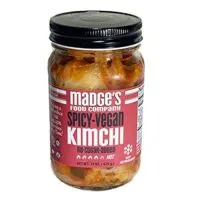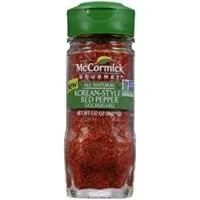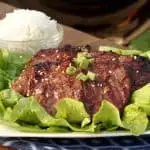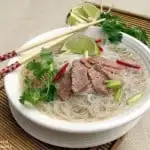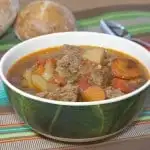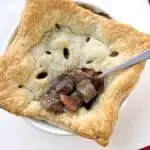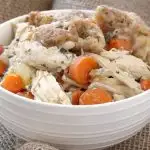Budae Jjigae, or Korean Army Base Stew, is a warming hot pot dish that is thick, spicy, and hearty. Perfect to warm you up on a cold winter day!
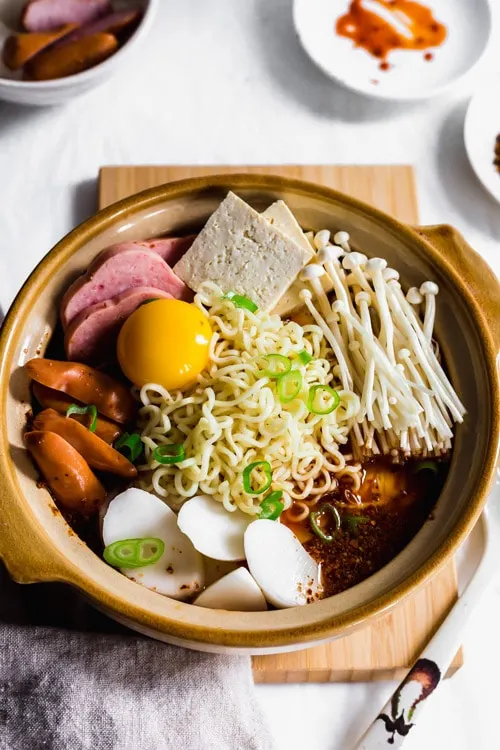
When the weather gets cold and chilly, all I want to eat is something steamy and comforting. Chinese hot pot and hot soup noodles, such as Vietnamese beef pho are my favourites.
But lately, I’ve delved more into Korean food, and discovered that there’s a dish that epitomizes hot pot and noodles into one.
Budae Jjigae.
Literally translated, it means “army base stew” in Korean.
History of Budae Jjigae: Why Is It Called Army Stew?
Food was scarce in South Korea after the Korean War. Budae Jjigae was created by using the food supplies left over from the war.
The people who lived around US Army bases collected surplus food like processed meats (such as SPAM and hot dogs) and canned goods like baked beans.
This stew is also known as “Jonseun Tang” (“Johnson Soup”) as the President of the United States at the time, Lyndon B. Johnson, was purported to have enjoyed the stew on a visit to South Korea.
What Is In Korean Army Stew
Budae Jjigae (Army Stew) is a thick, spicy, hearty stew flavoured with anchovy broth and gochujang.
It is a meat-centric dish and usually includes:
- SPAM (processed ham)
- hot dogs (Vienna sausages)
- pork
- ground beef
- tofu
- canned beans
- instant noodles
- tteok (rice cakes)
- American processed cheese
- mushrooms
- whatever vegetables are in season
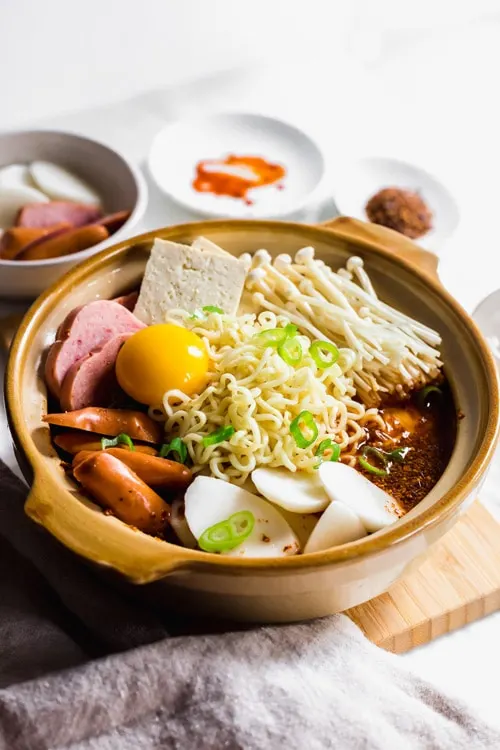
What Are Tteok?
Tteok are Korean rice cakes that can come in 2 different forms: thinly sliced and small logs.
For this stew, the sliced ones are easier to work with since they will cook up quickly. But, if you can only find the small logs, add a few more minutes to the overall cooking time.
Korean rice cakes can be found in Asian supermarkets, sometimes in the frozen section.
What Is Gochujang?
Gochujang is a Korean spicy red pepper paste that can be found in Korean/Asian supermarkets.
If you’re not able to find gochujang, you can try using a mixture of 1 Tbsp miso paste and 2 Tbsp sriracha chili sauce mixed with 1 tsp of sugar.
What Is Gochugaru?
Gochugaru is also known as Korean red pepper flakes. It is more finely ground than conventional red pepper flakes and is milder in spiciness. But it is slightly sweet and smoky in flavour.
It is commonly used in kimchi and in Korean Bibimbap.
If you don’t have access to gochugaru, you can use regular red pepper flakes, but use less. You won’t get that sweet and smoky flavour found in the Korean version, but it will give you the slightly spicy kick.
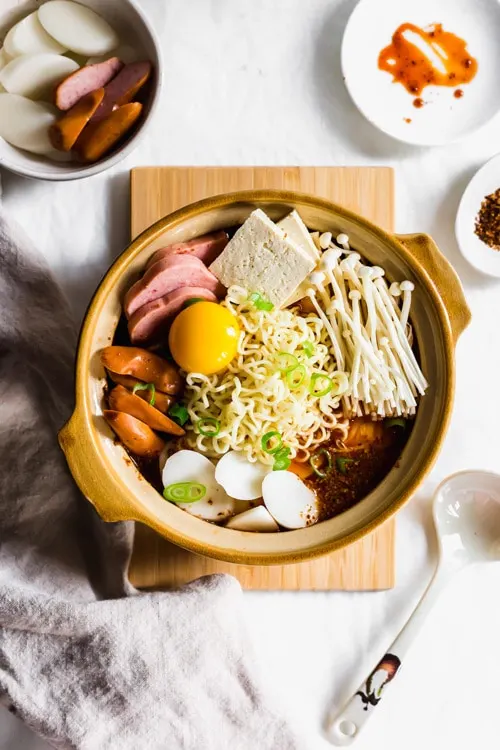
How To Make Budae Jjigae (Korean Army Stew)
You will need a large, shallow pot to prepare budae jjigae.
Typically, the dish is served at the table on a hot plate or burner to keep the stew piping hot (similar to Chinese hotpot). However, if you don’t have a hot plate or electric burner, you can still make this over the stove.
Most of the work in preparing this dish is in opening the cans!
It’s such a simple dish!
Then, the ingredients are set into the shallow pot with the anchovy and gochujang broth and left to simmer gently.
It is a slow-paced meal, where family gather together at the table to enjoy the dish piping hot.
My Budae Jjigae Recipe
I’ll be the first to admit, this dish is indulgent — with its high concentration of processed meat and sodium.
I have, on occasion, replaced the processed meats with hotpot beef, if you’re opting for a “healthier” alternative.
But for this recipe, I’ve kept it a little more authentic with the instant noodles and SPAM, which are really the main characteristics of this Korean stew.
(Note: You’ll notice that I didn’t use any processed cheese in my recipe. This is because my family doesn’t like the taste of it. But if you like it, by all means, add it in).

The great thing about budae jjigae is that you can customize the stew to your liking.
If you don’t like tofu, leave it out. If you’ve got canned kidney beans, add them in. Love eggs? Add them in. Got some frozen dumplings? Why not add them in too?
That’s the beauty of cooking and creating dishes.
And, if you enjoy Korean flavours, be sure to check out the classic Korean rice dish Bibimbap.
Budae Jjigae (Korean Army Stew)

Budae Jjigae, or Korean Army Base Stew, is a warming hot pot dish that is thick, spicy, and hearty. Perfect to warm you up on a cold winter day!
Ingredients
For The Soup Base
- 1 Tbsp anchovy paste
- 1 Tbsp gochujang paste (Korean red pepper paste)
- 2 Tbsp gochugaru (Korean red pepper flakes)
- 1 Tbsp rice wine
- 1 Tbsp light soy sauce
- 1 tsp granulated cane sugar
- 3 c vegetable broth
Stew ingredients
- 1 can SPAM, sliced
- 1 can Vienna sausages (or cocktail wieners), sliced on the diagonal
- 1 pkg enoki mushrooms, stems removed and gently rinsed
- ½ package firm tofu, sliced
- ¼ c kimchi
- ¼ c tteok (sliced Korean rice cakes), rinsed
- 1 slice American processed cheese (optional)
- 1 egg
- 1 package instant noodles (such as Ramen, noodles only)
- 2 Tbsp green onions, sliced
Instructions
- In a large bowl, mix together soup base ingredients. Set aside.
- In a large shallow pot, place all the stew ingredients except for the egg, instant noodles and green onions.
- Pour the soup base over top of the ingredients. Cover with a lid and bring the stew to a boil over medium heat (on the stove or a hot plate burner) until the stew begins to simmer, about 10 minutes.
- Reduce the heat to low and add in the instant noodles and raw egg. Continue to simmer until the noodles and egg are cooked.*
- Garnish with green onions and serve immediately. You can eat as is or serve with steamed rice and banchan (Korean side dishes).
Notes
*This is a starch-heavy stew, so you may need to adjust the amount of liquid in the pot, as the rice cakes and instant noodles will absorb quite a bit of liquid.
Recommended Products
As an Amazon Associate and member of other affiliate programs, We earn from qualifying purchases.
Nutrition Information:
Yield:
4Serving Size:
1/4 of recipeAmount Per Serving: Calories: 239
If you liked this recipe, here are some similar dishes you may enjoy!

Michelle enjoys learning and discovering different foods from around the world and recreating them in her own kitchen. She is an avid matcha lover and believes that the best food is made from scratch. Michelle develops and photographs recipes at her blog SiftAndSimmer.com.


